Giuseppe Penone was born in 1947 in Garessio, a village near Cuneo (Piedmont, Italy), lives and works in Turin and regularly stays in Paris.
It was in Turin that he exhibited for the first time, at the Deposito d’Arte Presente, and later at the gallery owned by Gian Enzo Sperone, where he had his first solo show in 1969.
Penone’s work reveals the interconnected nature of everything that exists.
He achieves this through the concrete (visual, tactile and olfactory) aspects of matter, which he explores until he uncovers its magical primal essence.
Even in his very earliest pieces, the artist experimented with a number of different materials (lead, iron, wax, pitch, wood, plaster and jute) bringing their individual physical qualities to the fore.

Alpi Marittime (Maritime Alps), 1968
In December 1968 he created a group of works, which he called Alpi Marittime (Maritime Alps) after the forested region where he was working. There he aligned his processes with those of nature itself, in order to assert (a key idea in his work), the principle of the identity of man and nature. Maritime Alps, which takes the form of a kind of diary, with associated drawings, photographs and brief annotations, was published in the book Arte Povera, by Germano Celant, in 1969.
Since then, Penone has been one of the leading exponents of the critical theory that Celant had begun to develop in 1967, and he has taken part in the debate with contemporary international avant-gardes conducted through the medium of a series of exhibitions, including Konzeption / Conception at Schloss Morsbroich in Leverkusen in 1969, Conceptual Art, Arte Povera, Land Art at the Galleria Civica d’Arte Moderna in Turin, and Information, at the Museum of Modern Art, New York, in 1970.
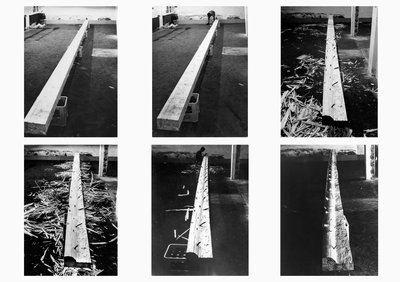
Albero di 12 metri (12-metre Tree), 1970
The tree, a living organism whose appearance is very similar to that of the human figure, is a central element in Penone’s work, a "primal and most simple idea of vitality, of culture, of sculpture".
In 1969 he created his first Alberi (Trees), each obtained by stripping a wooden beam and following one growth ring in order partially to uncover the trunk and branches, as they would have appeared before the tree was felled.
During Aktionsraum 1 in Munich in 1970, Penone carved out his Albero di 12 metri (12-metre Tree) in public. This piece was bought that same year by Pontus Hultén for the Moderna Museet in Stockholm, and was the first of Penone’s works to become part of a public collection. A later 12-metre Tree (1980), hewn out to its full length except for one end, which was left untouched as a block to be used as a base, was exhibited at the Solomon R. Guggenheim Museum, New York (1982), and at the Musée des Beaux-Arts, Nantes (1986). By contrast, in his imposing Cedro di Versailles (Versailles Cedar) of 2000–03 the shape of the young tree was arrived at by excavating the trunk of an ancient cedar from the forest of Versailles.
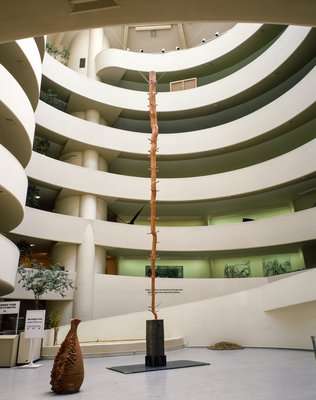
Albero di 12 metri (12-metre Tree), 1980
Soffio (Breath), 1978
Over the years, Penone has created a considerable number of variations on his Trees theme, which have found their logical place in the thinking that lay behind his Ripetere il bosco (Repeating the Forest). Under this title he has juxtaposed various Trees for a number of exhibitions, including those at the Stedelijk Museum, Amsterdam (1980), at the Castello di Rivoli, Turin (1991), and at the Art Gallery of Ontario (AGO), Toronto (2008).
Boundaries, in other words, what defines the individuality of every object and every living thing, are another central concept in Penone’s work.
The artist sees them as borders, thus implying, and focusing on mutual contact. This can be deduced from the processes Penone uses in his work: processes based on the relationship between separate, at times opposed entities, which by coming into contact, modify and determine each other.
In his first solo exhibition, at the Gian Enzo Sperone gallery in Turin in 1969, Penone exhibited Indicazione del pavimento (Indication of the Floor), Indicazione del muro (Indication of the Wall), Indicazione dell’aria - Barra d’aria (Indication of the Air - Bar of Air). This last one is a long glass tube with a square profile that transects a windowpane, bringing into the room air and noises from outside and thus creating a relationship between things that are normally considered separate.
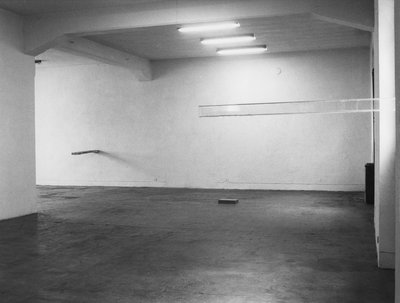
Galleria Sperone, Torino 1969
In Rovesciare i propri occhi (Reversing One’s Eyes) of 1970, Penone wore reflecting contact lenses, which block the channel of visual information between the individual and his surroundings, and used photographs to record and show at some future time the images that his own eyes would have perceived.

Rovesciare i propri occhi (Reversing One’s Eyes), 1970
After this pivotal work, Penone focused on the sense of touch, working on a cycle of pieces entitled Svolgere la propria pelle (Unrolling one’s own Skin). Reflecting on the countless voluntary and involuntary traces bodies leave around themselves, he "unrolled" his own imprints onto different elements: the neon lights in an art gallery, or the windowpanes in the Museum Fridericianum in Kassel during the 1972 Documenta 5. With his series Pressione (Pressure), from 1974 onwards, and Palpebre (Eyelids), from 1977 onwards, Penone reflected on the automatic and unconscious image of the imprint, making it conscious and voluntary through the individual, irreplaceable act of drawing, which enlarged it and retraced it in all its parts. The process he used consisted of photographing an imprint, projecting its magnified image onto different supports, and then tracing over it with charcoal or graphite. Sometimes he turned the concept of internal and external on its head, "unrolling his own skin" onto the walls enclosing a space: the skin (by definition an external element) was "unrolled" onto walls that contained and enveloped visitors to the Kunstmuseum, Lucerne (1977), MoMA, New York (1982), the National Gallery of Canada, Ottawa (1983), and the Musée d’Art Moderne de la Ville de Paris (1984).
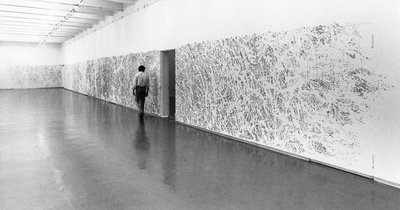
Pressione (Pressure), 1977
Contact, and the imprints representing its memory, thus became the matrix of Penone’s work. Through this process he renewed the practice of sculpture, interpreting in completely novel ways traditional techniques such as moulding and lost-wax casting.
In 1972 he began to create a series of works using the plaster cast of a part of his body, onto which he projected the image of the mould photographed after the cast was made. In these works, in which the hairs ripped off by the plaster are mixed with those that are left on the skin and are visible in the slide, he connects the idea of a boundary with something that cannot be controlled, namely hair, which is the longest extension of our bodies and which acquires an independent dynamism by being subject to the action of wind, water and the hairdresser. The first in this series of works, Torace (Thorax, 1972), was part of his solo exhibition at the Paul Maenz Gallery, Cologne, in 1973.
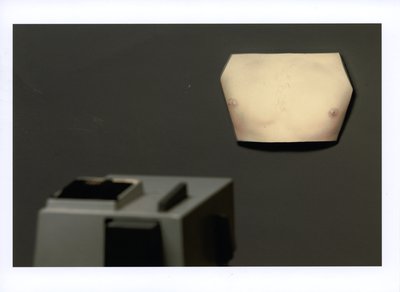
Torace (Thorax), 1972
The observation and recording of contact as an active process of remembering also gave shape to his 1975 work entitled Vaso (Vase), consisting of a terracotta vessel from an archaeological dig, and of the enlargement, in four bronze sculptures, of the imprints left on it by the potter. This was the first time Penone used bronze, employed, in this case, "to create a myth", as the artist put it, "or a rhetoric on the banality of the imprint left by the craftsman". Created years later, in 2005, the large sculptures in bronze and steel entitled Geometria nelle mani (Geometry in Hands) are also based on the enlargement of an imprint left, in this instance, by the hand of the artist, who frequently tested with his own body the parameters of the act of contact.
In his 1978 solo show at the Museum Folkwang in Essen, Penone exhibited the first of his terracotta pieces entitled Soffio (Breath), in which he gave shape to the volume of his breath in contact with his own body, lending breath plasticity in the form of a clay vessel, whose opening is a cast of the inside of the artist’s mouth.

Soffio (Breath), 1978
Dated 1979, the piece entitled Soffio di foglie (Breath of Leaves) is a pile of leaves showing the imprint of the artist’s body and breath.
In the late 1970s, Penone published his thoughts on the practice of sculpture. Jean-Christophe Ammann, in his text written on the occasion of Penone’s 1977 solo show in Lucerne and reprinted in the anthology of essays by the artist published in the same year (Rovesciare gli occhi, Einaudi, Turin), identified in the works "a plastic attitude in its essential characteristic". In 1997 Georges Didi-Huberman described it as "sculpture that transforms objects into subtle actions".
Penone has always seen sculpture in relation to nature and in terms of an action that repeats, or in any case is interwoven with, the behaviour of his chosen materials.
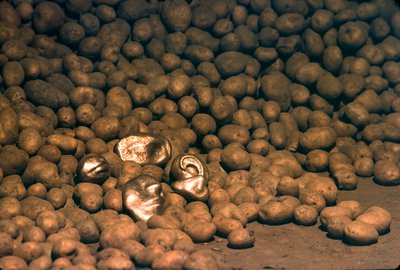
Patate (Potatoes), 1977
Patate (Potatoes), dated 1977, was exhibited for the first time in his solo exhibition at the 1978 Staatliche Kunsthalle in Baden-Baden, for which Penone cast in bronze a number of tubers grown in soil in contact with a negative mould of a human face.
Essere fiume (Being a River), the title piece of the 1981 exhibition in the Konrad Fischer Gallery in Düsseldorf, was created by carving a stone in emulation of the action of a river.
In 1982 Penone cast Soffio di foglie (Breath of Leaves) in bronze, thus giving lasting life to the ephemeral work created using vegetal elements. The artist’s use of bronze has always been connected with vegetation. Using the lost-wax casting technique he has explored, as always in his work, the material’s own logic, and has worked it in accordance with its inherent expressive possibilities. Wax is one of the most pliable of materials; it moulds itself to the imprints of other bodies and preserves in its shape the memory of this contact. "According to Socrates", wrote the artist in a 1989 text, "in our soul is a block of wax, which is memory, a gift of the Muses". According to the artist, the affinity between bronze and vegetation is chromatic – when exposed to atmospheric agents, the metal’s surface oxidizes and takes on a range of colours similar to those of trees – but it also lies in the way the metal is able to ‘fossilize’ the contact, enacting in a shortened space of time the slow process undergone by trees.
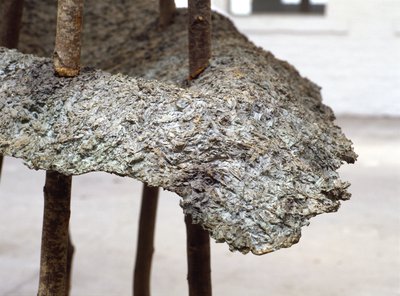
Soffio di foglie (Breath of Leaves), 1982
In Gesti vegetali (Vegetal Gestures), the bronze sculptures created from 1982 onwards and initially exhibited in the Konrad Fischer Gallery, Zurich, the Stein Gallery, Turin, the Fort Worth Museum and the Museum of Contemporary Art, Chicago, Penone ‘fossilized’ the prints of his hands in vaguely anthropomorphic shapes, which he then interwove with growing plants, as shown in the Merian Park, Basel, in 1984, and the following year at the Marian Goodman Gallery in New York.
The trees Penone has installed in various public places are also cast in bronze. They include his Pozzo di Münster (Münster Well), made for the 1987 Skulptur-projekte (along its trunk the imprint of a hand has created a bifurcation from which water spurts), and his Albero delle vocali (Vowel Tree) in the Jardin des Tuileries in Paris, where it has been installed since the year 2000.
Fingernails, like hair and individual hairs, are extensions of the body. They are what we use to explore or handle a material, but they are also the place where, after that contact, the material solidifies or settles. Starting from 1987, Penone has created large glass sculptures in the shape of fingernails and has placed them in contact with different materials: heaps of leaves, forest trees, tree trunks and blocks of marble. In 1988 the Musée Rodin in Paris devoted an entire exhibition to them.
In Penone’s work, during recent decades especially, the preferred focus has been knowledge based on analogy – a type of experience considered pre-logical in Western thought, but one that the artist has revived and legitimized by virtue of imagination.
In other words, if Penone’s visionary ability once enabled him to reveal the original shape of a tree or to ‘make concrete’ a contact, it now enabled him to work and put together different materials emphasizing their similarities. The basis of his graphic and sculptural works, in fact, has continued to be his belief in the common nature of everything that exists.
In the large-scale drawings entitled Foglie (Leaves), the traces imprinted on the inner surface of the skull by a soft matter such as the brain are transformed into images of leaves. In Anatomie (Anatomies), first exhibited in 1992 at the Réfectoire de l’Abbaye de Tournus, Penone carved the surface of Carrara marble, the traditional material for statuary, bringing out its veining, which is so similar to the vessels through which blood flows in humans.
In the pieces entitled Trappole di luce (Light Traps), from 1993 onwards, tree trunks are represented by structures made of crystal, a material capable of capturing light – the tree’s primary source of life and growth.
In Albero delle vertebre (Vertebrae Tree), published in the catalogue accompanying the exhibition that toured the museums of Nîmes, Tilburg and Trento in 1997–98, a crystal ‘tree trunk’ emerges from plaster shapes obtained by enlarging casts of a human cranium.
In the cycle called Propagazioni (Propagations), from 1994 onwards, the concentric lines derived from a fingerprint expand into a pattern of waves.

Respirare l’ombra (To Breath the Shadow), 2008
Respirare l’ombra (Breathing the Shadow), a room lined with laurel leaves, first shown at the Centro Galego de Arte Contemporánea, Santiago de Compostela, in 1999, and at the Palais des Papes, Avignon, in 2000, features a lung, whose lobes are formed by laurel leaves cast in bronze and then gilded.
In the bronze works entitled Pelle di foglie (Skin of Leaves), from 1999 onwards, the leaves bear a resemblance to the endings of nerves or veins – as suggested by a thick mesh of branches.
In Pelle di marmo e spine d’acacia (Skin of Marble and Acacia Thorns), a series Penone started working on in 2000 and which he has exhibited from 2001 at the Musée d’Orsay in Paris and at the Fujikawa Gallery in Osaka, the marble is softened by the relief pattern of veins, which then extends into a pattern of acacia thorns. In other pieces the acacia thorns are placed so that they trace a magnified imprint of the skin, transforming it into a landscape, and echoing, with their sharp points, the skin’s system of nerve endings.

Pelle di marmo e spine d’acacia (Marble Skin and Acacia Thorns), 2001
In Pelle di grafite (Skin of Graphite), from 2002 onwards, Penone offers a free interpretation of the magnified traces of skin imprints.
First exhibited at the Centre Georges Pompidou, Paris (2004), the piece entitled Pelle di cedro (Skin of Cedar, 2002) consists of the imprint of the bark of a tree, pressed onto cowhide. The roughness of the bark transferred onto the hide emphasizes the similarities between the venous, nervous and lymphatic systems. The same pattern marks the panels of hide hanging on the walls of the Italian Pavilion at the 2007 Venice Biennale, in the work entitled Corteccia di cuoio (Bark of Leather) and also in Pelle di marmo – cervello (Skin of Marble – Brain), the marble floor where its veins, in relief, trace an approximation of the shape of the brain. In Scultura di linfa (Sap Sculpture), the piece which gives its name to the group of three inseparable linked works, sap is evoked everywhere and materializes in a hollow (the negative of a tree) carved out in the two halves of a beam.
With the series of works entitled Scrigno (Casket) – one of the earliest examples of which was exhibited at the Museo d’Arte Moderna di Bologna (MAMbo) in 2008 and at the Toyota Municipal Museum of Art in 2009 – Penone opened a parenthesis in his pursuit of the affinity between the vegetable and animal worlds: a bronze tree trunk split in half is suspended horizontally across a hanging surface of veined hide. A system of hinges allows the blood-red resin inside to be concealed or revealed. Red resin also fills the hollow carved out of a tree in Matrice di linfa (Sap Matrix, 2008), a work exhibited at the École Nationale Supérieure des Beaux-Arts (ENSBA), Paris (2009), and at the Musée des Arts Contemporains (MAC), Site du Grand-Hornu (2011), in which the principle of analogy becomes visible through the use of different materials: bronze, wood, clay and leather.
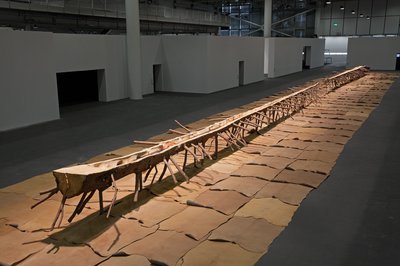
Matrice di linfa (Sap Matrix), 2008
The imprint of bark on skin was cast in bronze in Lo spazio della scultura (The Space of Sculpture), the piece initially shown at the Studio per l’Arte Contemporanea Tucci Russo in Torre Pellice, Turin, at the Museum Kurhaus, Kleve, and at Villa Medici, Rome, between 2006 and 2008.
In Limine, the bronze tree created in 2011 as a kind of archway for the Galleria Civica d’Arte Moderna e Contemporaea (GAM) in Turin, shows the ramifications of its roots seamlessly merging with those carved out in the marble block that acts as its base, while at the other end its metal branches touch those of a lime tree.
For Penone ‘the structure of fluids is the same as that of all elements. A watercourse, a growing tree and a path, all have similar shapes’.
In 2002, for a disused railway link in Turin, he designed a path which, in plan, was shaped as a tree, and left it to become overgrown. In 2007, at the invitation of Ida Gianelli, he completed his Giardino delle sculture fluide (Garden of Fluid Sculptures) in the gardens of the Venaria Palace, Turin.
In this kind of ideal pathway through his work, in dialogue with the more formal nature of the gardens, we find his Tra scorza e scorza (Between the Barks), the pond entitled Disegno d’acqua (Water Drawing), Anatomia (Anatomy), Pelle di marmo (Skin of Marble), Chiaroscuro, Cervello di pietre (Brain of Stones), Biforcazione (Bifurcation), Direzione verso la luce (Towards the Light), Direzione verso il centro della terra (Towards the Centre of the Earth), and Idee di pietra (Ideas of Stone).
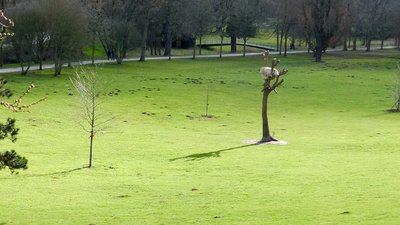
Idee di pietra (Ideas of Stone), 2003
In the series of works entitled Ideas of Stone, the most recent of which was exhibited in October 2011 in Kassel prior to Documenta 13, the dialogue between mental and physical spaces, between thought and matter, already explicit in many of Penone’s works, and in fact present in his entire opus, takes a different form, one in which, as the artist himself says, "the idea that appears suddenly, or after a long reflection, in space and free of any mental force of gravity [...] is a stone from a river appearing among the branches of a tree".
[From Daniela Lancioni, "Biography", in Giuseppe Penone, edited by Laurent Busine, Mercatorfonds, Brussels 2012, pp. 392–94]
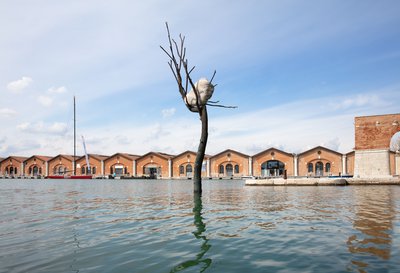
Idee di pietra - Olmo (Ideas of Stone - Elm Tree), 2008